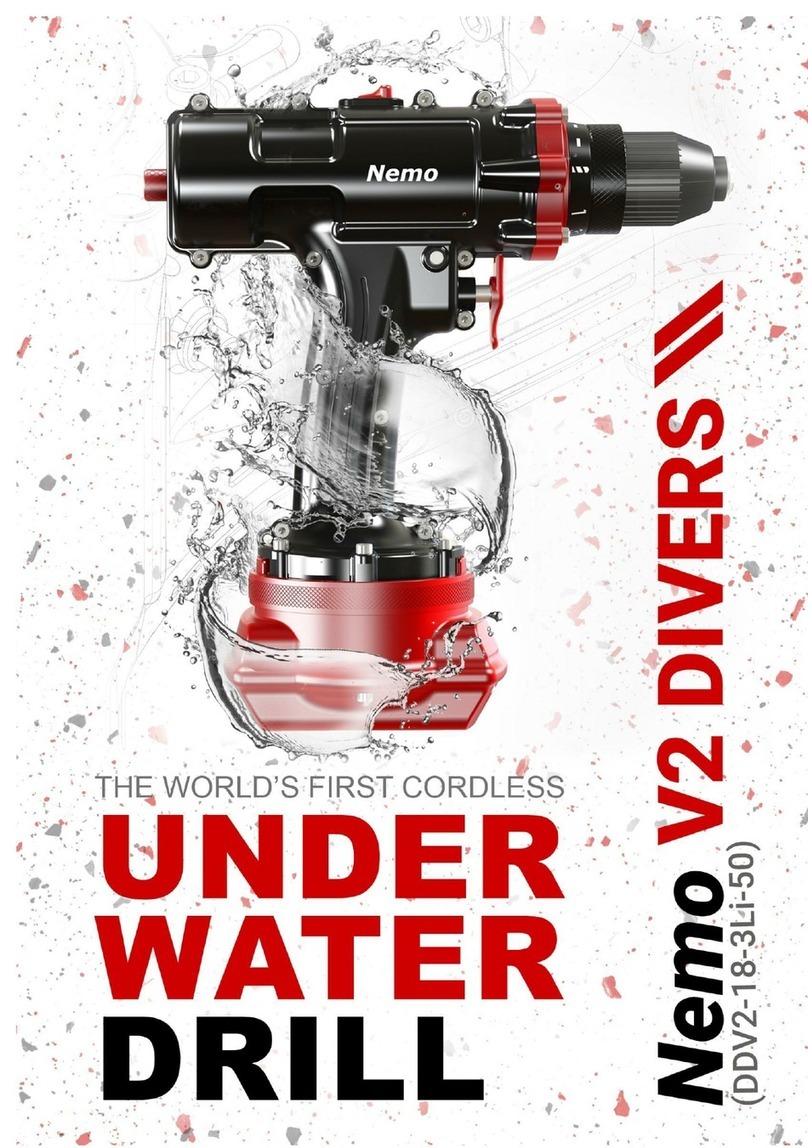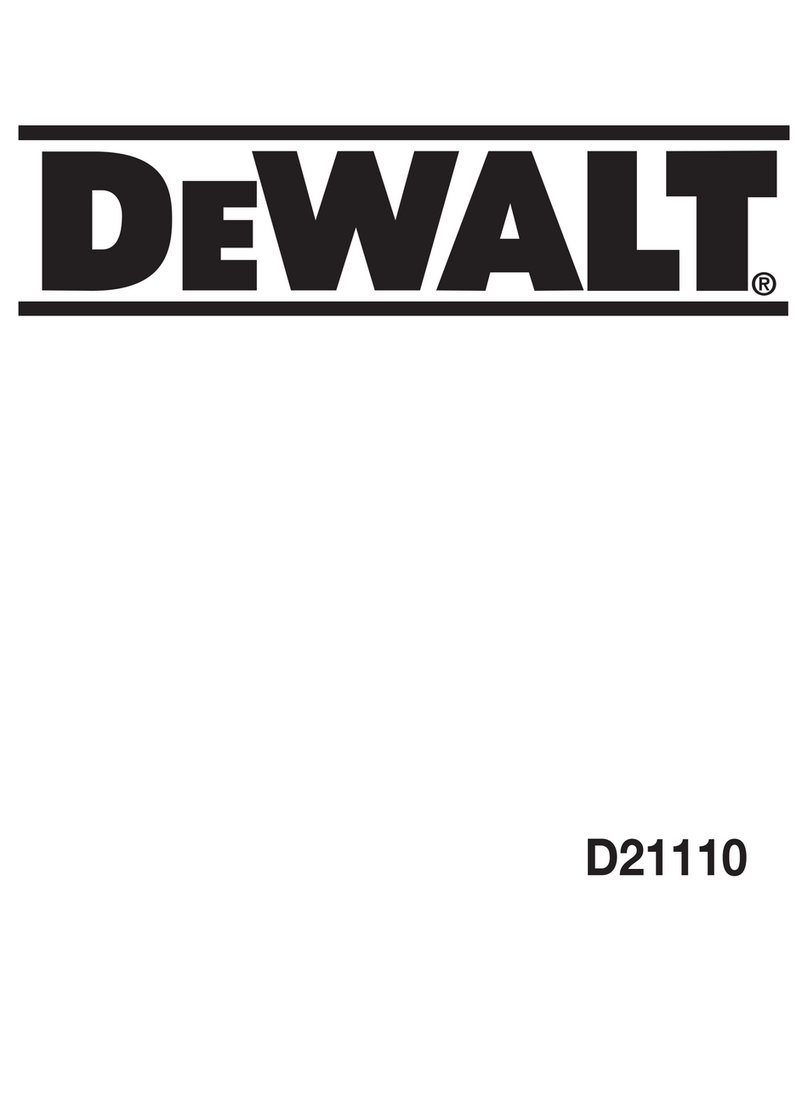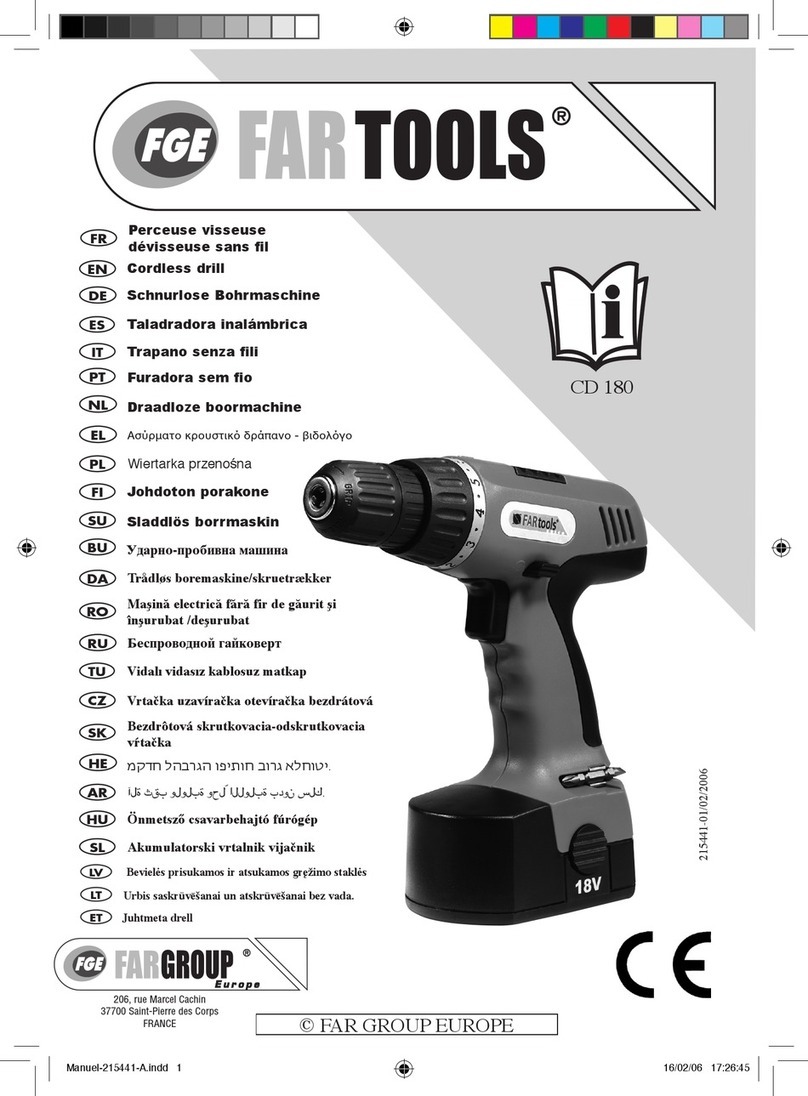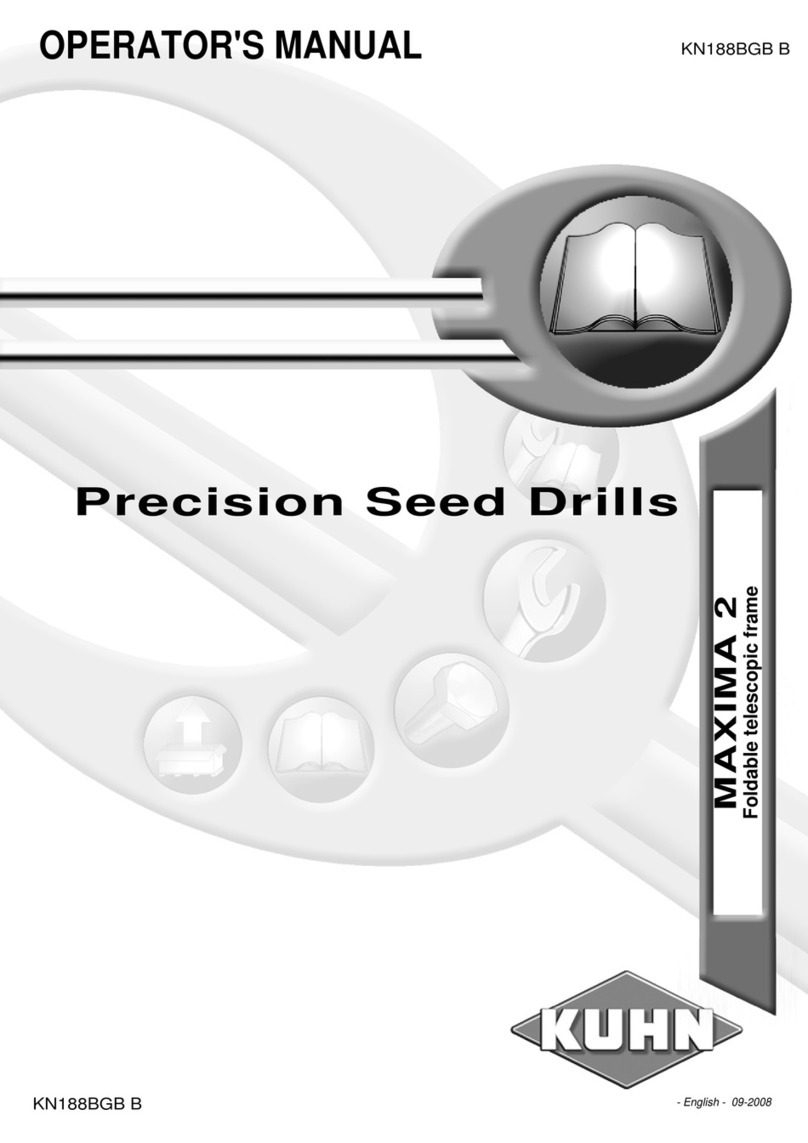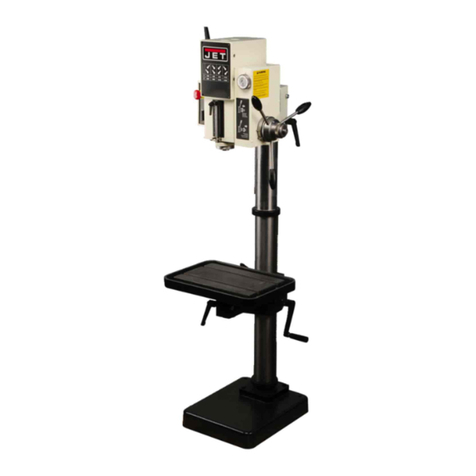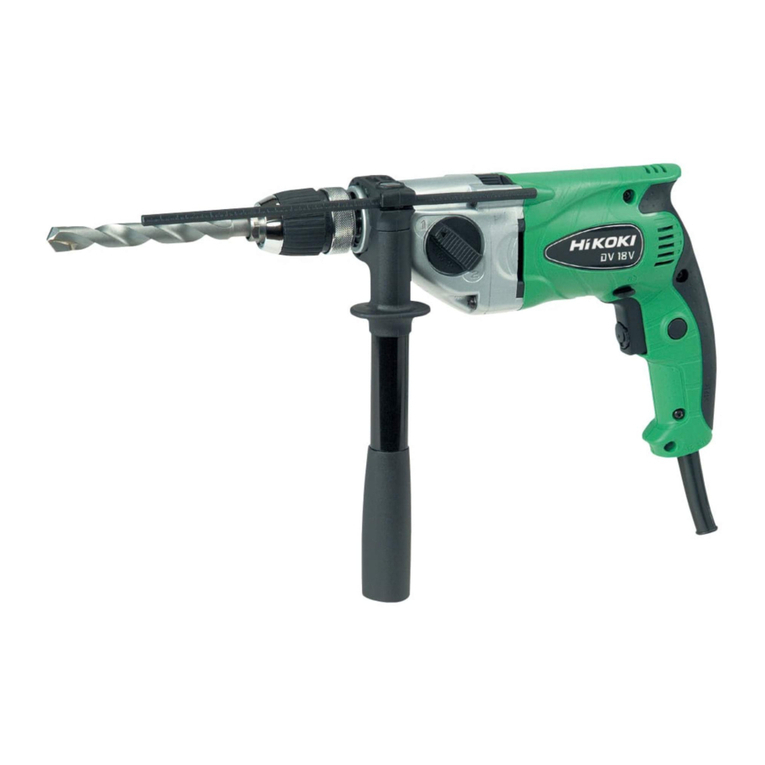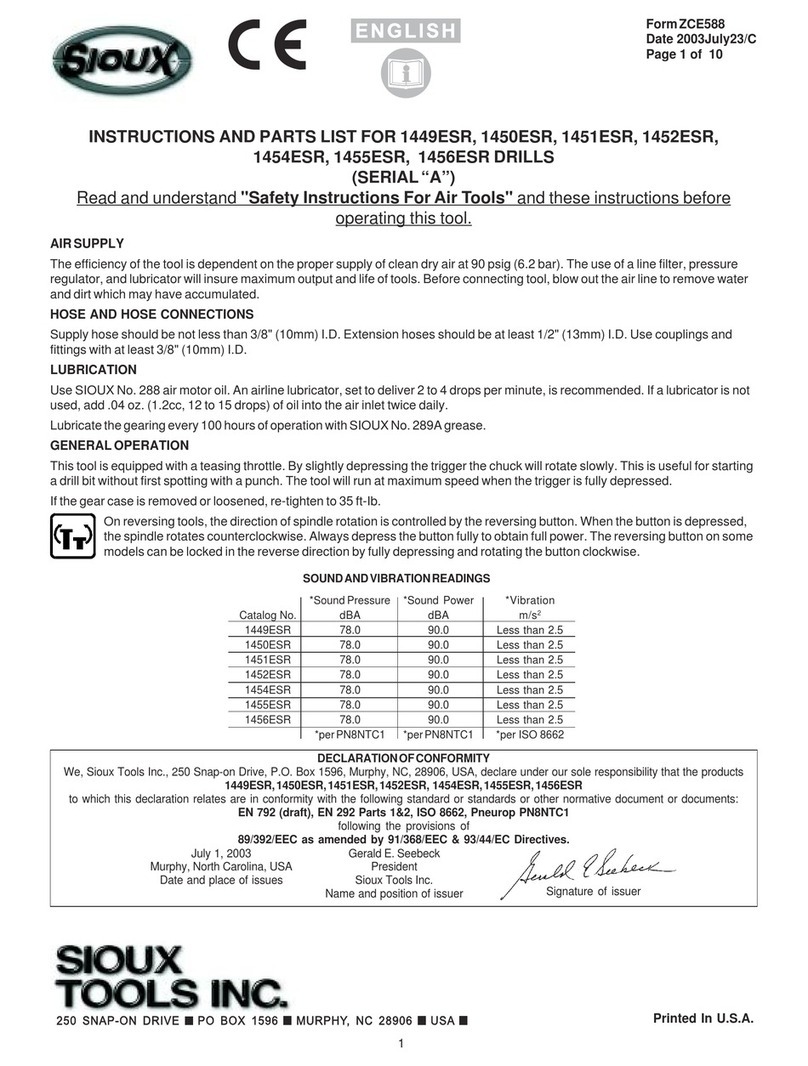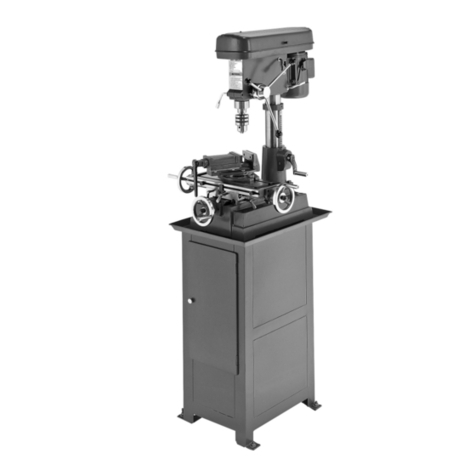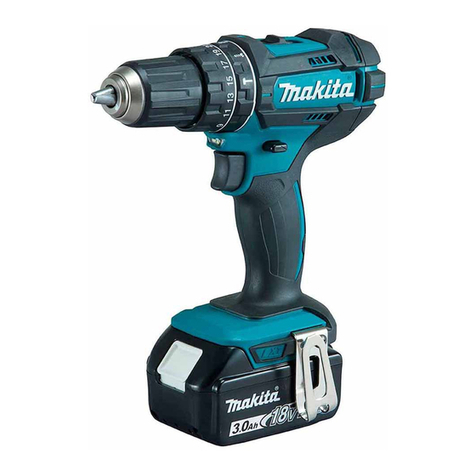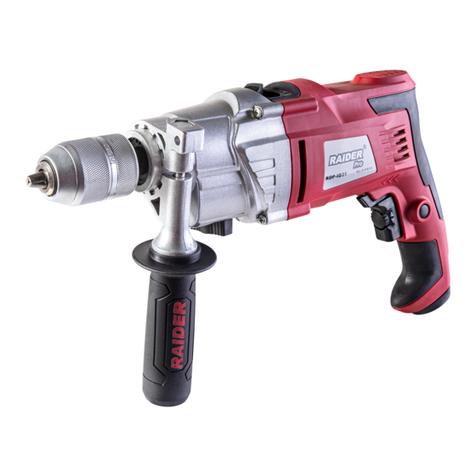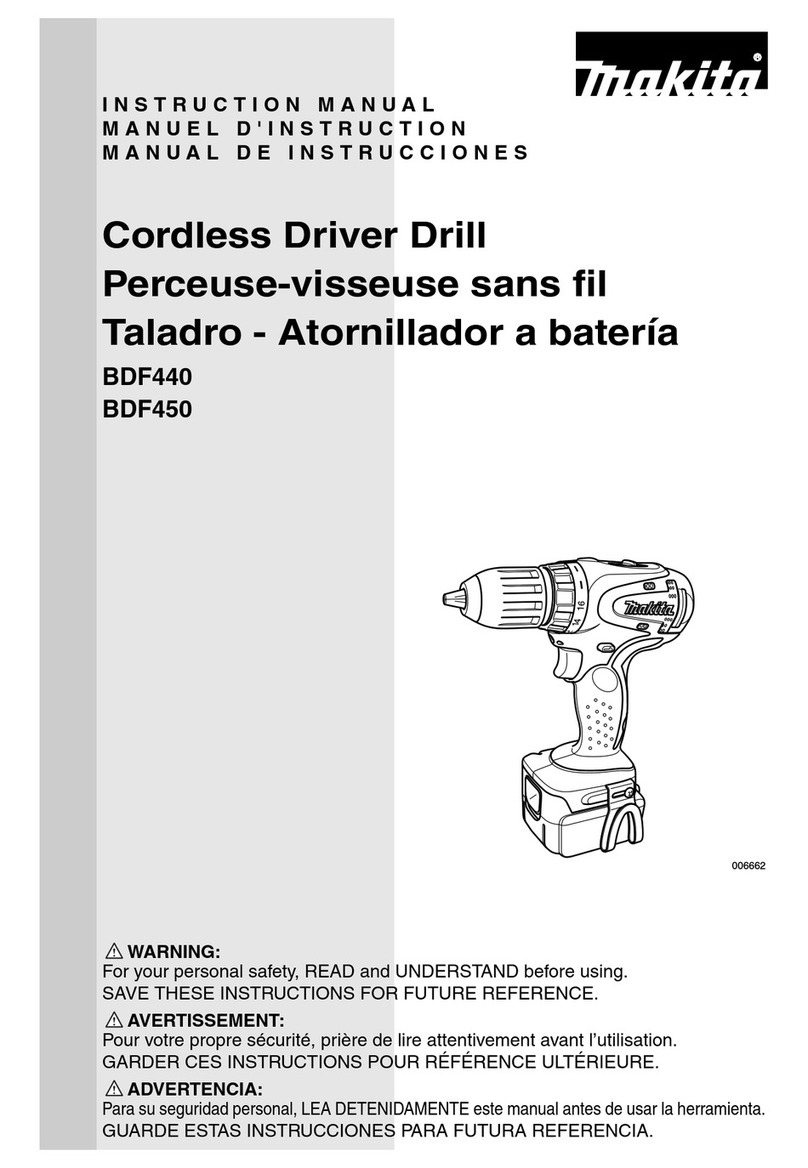Nemo HD-18-3Li-50 User manual


1
Functional Description and Specifications
Intended Use
The Nemo Submersible Hammer Drill is intended to drill tough
materials such as cement, brick, blocks, or stone, and can be used
underwater, in wet conditions, and on dry land.
Packing List
Your Nemo Submersible Hammer Drill is packaged together with
the following accessories:
♦Two rechargeable lithium-ion (Li-ion) battery packs
♦Battery charger
♦Hand pump
♦Side handle and positioning ring
♦Carrying case

2
Technical Specifications
Nemo Submersible Hammer Drill
Model HD-18-3Li-50
Battery pack voltage 18V Li-ion
Battery cell specification 3Ah
No load speed (two speeds) 0 – 400 / 0 – 1500 RPM
No load BPM 0 – 17600 BPM
Maximum torque 39 Nm (345 in-lbs)
Chuck size 13mm (½ in)
Net weight (with battery) 3.1kg (6.8 lbs)
Working temperature 60°C (140°F)
Submersible up to 50m (164 ft)
Battery Charger
Model DSS-220200
Approximate charging time 55 minutes
Charging output voltage 21V
Charging input voltage 100V – 240V
Caution: You must pressurize the hammer drill before
you can use it underwater, as described in Pressurizing
the Hammer Drill for Underwater Use, page 12.

3
Safety Warnings
Warning:Read all safety warnings and instructions, and
save them for future reference. Failure to adhere to
these warnings can result in serious injury and damage
to equipment.
Work Area Safety
♦All work should be done in accordance with the local, state,
and government occupational safety and health guidelines.
♦Keep your work area clean and well lit.
♦Do not operate power tools in explosive atmospheres, such as
in the presence of flammable liquids, gases, or dust.
♦Keep bystanders away when operating power tools.
Personal Safety
♦Stay alert and use common sense when operating power tools.
Do not use power tools when you are tired or under the
influence of drugs, alcohol, or medication.
♦Use personal protective equipment. It is recommended to
always wear eye protection, as well as a P2 filter-class
respirator.
♦Dust from materials such as lead-containing coating, some
wood types, minerals, and metal can be harmful to one’s
health. Observe the relevant regulations in your country for
the materials to be worked.

4
Power Tool Safety
♦Store idle power tools out of reach of children and do not allow
persons unfamiliar with the power tool or these instructions to
operate the power tool.
♦Maintain your power tools. Check for misalignment or binding
of moving parts, breakage of parts, and any other condition
that may affect the power tool’s operation. If damaged, have
the power tool repaired by an authorized service technician.
Caution:Under no circumstances should the power
tool be opened for repairs or any other purpose by
anyone other than an after-sales service technician
authorized by Nemo Power Tools. Opening the power
tool invalidates the manufacturer warranty.
♦Use power tools, accessories, and tool bits in accordance with
these instructions and in the manner intended for the
particular type of power tool, taking into account the working
conditions and the work to be performed. Consult local, state,
and government occupational safety and health guidelines
before operating a power tool.
♦Switch off the power immediately if the tool insert jams. Be
prepared for high reaction torque than can cause kickback. The
tool insert can jam when the power tool is subject to overload,
or if it becomes wedged in the workpiece.
♦Hold the power tool with a firm grip. High reaction torque can
briefly occur while driving in and loosening screws.
♦Work only on secured, stable items. Do not hold any item to be
worked on by the power tool in your hand. Secure the
workpiece, clamped with clamping devices or in a vice, to
ensure safety.
♦Always wait until the power tool has come to complete stop
before placing it down. The tool insert can jam and lead to loss
of control over the power tool.

5
Rechargeable Battery Safety
♦Use only the battery pack supplied with your power tool.
♦When the battery pack is not in use, keep it away from other
metal objects like paper clips, coins, keys, nails, screws, which
can make a connection from one terminal to another.
♦Store the battery pack only within a temperature range of 0˚C -
45˚C (32˚F - 113˚F).
♦Before any work on the power tool, such as a tool change, as
well as during transportation and storage, remove the battery
pack from the power tool. There is danger of injury when
accidently activating the On/Off trigger.
♦Do not open the battery.
♦Protect the battery against heat, including continuous sun
irradiation and fire.
♦When the battery is defective, liquid can escape and come into
contact with adjacent components.
♦Use only original batteries with the voltage listed on the
nameplate of your power tool. When using other batteries,
such as imitations, reconditioned batteries, or other brands,
there is danger of injury as well as property damage through
exploding batteries.
♦Use only the battery charger provided with the power tool to
recharge the batteries. Only this battery charger is matched to
the lithium-ion (Li-ion) batteries of your power tool.
♦Protect the battery charger from rain and moisture. The
battery charger is not waterproof.
♦Do not charge other batteries. The battery charger is suitable
only for charging the battery pack supplied with the tool.
♦Before use, always check the battery charger, cable, and plug.
If defects are detected, do not use the battery charger. Never
open the battery charger. Instead, have it opened and repaired
only by qualified personnel who will use original spare parts.

6
Getting Started with the Hammer Drill
Your Nemo Submersible Hammer Drill (IW-18-3Li-50) includes the
following main components:

7
Charging the Battery
The Li-ion batteries are supplied partially charged, and must be
charged to full capacity using the battery charger provided with the
hammer drill before using the hammer drill for the first time.
Caution: Only use the battery charger provided with
the hammer drill. Only this battery charger is matched
to the Li-ion batteries supplied with your power tool.
Danger:Ensure that the voltage of the power supply
corresponds with the data given on the nameplate of
the battery charger.
Danger:Only use the charger in a dry environment. The
charger is not waterproof. Never attempt to charge the
battery under water.
A battery can be charged at any time without reducing its service
life. This is because the battery charger detects the charging
condition of the battery, and charges it with the optimum current
according to its temperature and voltage. This lengthens the
battery life, and leaves it fully charged when stored in the charger.
Interrupting the charging procedure does not damage the battery.
1. Connect the mains plug of the battery charger to an electrical
outlet. A steady green light on the battery charger indicates
that the charger is ready for operation.
2. Press the battery charger’s CHOGORI connector into the socket
on the top of the battery pack. There is only one way to insert
the CHOGORI connector into the battery socket.

8
The battery begins charging as soon as it is connected to the
charger.
A steady red light on the battery charger indicates that
the battery is charging.
A steady green light on the battery charger indicates that
the battery is fully charged.
Note:The battery is equipped with an NTC
temperature controller that only allows it to be
charged when its temperature is between 0˚C- 45˚C
(32˚ F - 113˚ F), ensuring a long battery service life.
3. When you are ready to use the battery, rotate the CHOGORI
connector’s plastic cap counterclockwise and pull it vertically
out of the charger.
Inserting a Battery in to the Hammer Drill
1. Set the rotational direction switch to the middle position.
Caution:To minimize the risk of accidental activation,
always ensure the rotational direction switch is in the
neutral (middle) position before performing any
maintenance work on the hammer drill, as well as
during transportation and storage.
2. Insert the battery into the bottom of the hammer drill base.
Caution:Use only a Li-ion battery from the original
factory with the voltage listed on the nameplate of
your hammer drill. Using other batteries not suitable
for the hammer drill can lead to malfunctions, cause
damage to the power tool, and pose a fire hazard.
3. Push the battery up until it is pushed to the limit, then rotate
the locking ring until it is securely locked. The locking ring holds
the battery pack in position and prevents it from detaching.

9
Removing a Battery from the Hammer Drill
1. Set the rotational direction switch to the middle position.
Caution:To minimize the risk of accidental activation,
always ensure the rotational direction switch is in the
neutral (middle) position before performing any
maintenance work on the hammer drill, as well as
during transportation and storage.
2. Rotate the locking ring counterclockwise. The locking ring
holds the battery pack in position and prevents it from
detaching.
3. Pull the battery pack out and down, without exerting any
force.
Inserting a Tool in to the Hammer Drill
The hammer drill spindle is locked whenever the On/Off trigger is
not pressed. This ensures quick, convenient and easy changing of
the tool in the keyless chuck.
1. Set the rotational direction switch to the middle position.
Caution:To minimize the risk of accidental activation,
always ensure the rotational direction switch is in the
neutral (middle) position before performing any
maintenance work on the hammer drill, as well as
during transportation and storage.
2. Ensure that the On/Off trigger is not pressed.
3. Turn the chuck sleeve counterclockwise until it is open wide
enough to fit the tool.
4. Insert the tool in to the chuck, placing it as far as it will go.
5. Firmly tighten the chuck sleeve by hand, clockwise, to tighten
the chuck.
6. To remove the tool, loosen the chuck sleeve counterclockwise
until the tool is free.

10
Replacing the Keyless Chuck
1. Set the rotational direction switch to the middle position.
Caution:To minimize the risk of accidental activation,
always ensure the rotational direction switch is in the
neutral (middle) position before performing any
maintenance work on the hammer drill, as well as
during transportation and storage.
2. The keyless chuck is secured with a securing screw to prevent it
from unintentionally coming loose from the hammer drill
spindle. Remove this screw by completely opening the chuck
and unscrewing the screw, which has a left-handed thread, in a
clockwise direction.
3. Remove the chuck as follows:
a) Place the hammer drill on a stable surface, such as a
workbench.
b) Clamp the short end of an Allen key in to the chuck.
c) Turn the Allen key counterclockwise to loosen the chuck.
d) Remove the Allen key from the chuck and completely
unscrew the chuck by hand.
4. Mount a new chuck on to the hammer drill as follows:
a) Screw the chuck clockwise on to the hammer drill by hand.
b) Clamp the short end of an Allen key in to the chuck.
c) Turn the Allen key clockwise to tighten the chuck to a
tightening torque of approximately 20-25 Nm.
5. Open the keyless chuck completely, and screw in the securing
screw counterclockwise, to a tightening torque of
approximately 4-5 Nm.

11
Mounting a Handle on to the Hammer Drill
1. Fit the positioning ring on to the body of the hammer drill.
2. Use an Allen key to tighten the screw that secures the
positioning ring in place.

12
3. Insert the handle in to the hole on the side of the positioning
ring, and screw it in tightly.
Pressurizing the Hammer Drill for Underwater Use
Your hammer drill can be used in any wet conditions, and can be
submerged and used underwater at depths of up to 50m (164ft).
Before submerging the hammer drill to any depth, it must be
pressurized.
1. Remove the red cap from the pressure valve on the back of the
hammer drill.

13
2. Attach a pump, such as the hand pump supplied with the
hammer drill, to the valve.
3. Pressurize the hammer drill according to the depth to which
you are going to submerge it, as follows:
Depth Pressure
Up to 5m Minimum 1 Bar
Up to 10m Minimum 2 Bars
Up to 20m Minimum 3 Bars
Up to 30m Minimum 4 Bars
Up to 40m Minimum 5 Bars
Up to 50m Maximum 6 Bars
Caution:Never add more than 6 Bars of pressure to the
hammer drill.

14
Best Practices for Underwater Operation
Your Nemo Submersible Hammer Drill is designed to be
waterproof, so that it can be used both on land and underwater. To
obtain the maximum serviceable life of your hammer drill, adhere
to the following best practices when using the hammer drill
underwater:
♦You must pressurize the hammer drill before you can use it
underwater, as described in Pressurizing the Hammer Drill for
Underwater Use, page 12.
♦Do not exceed the maximum operational depth as
recommended by the manufacturer.
♦The hammer drill is hi-tech piece of equipment and should be
treated with care. Its watertight seals may be damaged if it is
dropped.
♦When moving about or working underwater, the hammer drill
should be secured to you by a tool leash at all times.
♦The hammer drill may be used in salt water.
Note:After using the hammer drill in salt water,
immediately rinse it in fresh water to remove all salt
residue.
♦Before storing the hammer drill in the carrying case after use in
water, flush it with fresh water and dry it off.
♦Treat the high quality battery with care. Keep the battery fully
charged and dry, ready for use, and always store it in the
carrying case when not in use.
♦Before inserting the battery in to the hammer drill, check that
the three O-rings on the battery are present and undamaged.
Caution:If any of the O-rings is missing or does not seal
completely, water can enter the hammer drill or
battery, causing serious damage.

15
Operating the Hammer Drill
Setting the Working Mode
The hammer drill can function in regular drill mode, as a regular
drill and driver, or in hammer mode. For more information, see
Performing Hammer Drill Operations with the Hammer Drill, page
19, and Performing Regular Drill Operations with the Hammer Drill,
page 19.
1. Set the rotational direction switch to the middle position.
Caution:To minimize the risk of accidental activation,
always ensure the rotational direction switch is in the
neutral (middle) position before performing any
maintenance work on the hammer drill, as well as
during transportation and storage.
2. Do one of the following:
To work in regular drill mode, turn the mode selection
ring until the three dots on the mode selection ring are
aligned with the single dot on the middle ring.

16
To work in hammer mode, turn the mode selection ring
until the hammer symbol on the mode selection ring is
aligned with the single dot on the middle ring.
Important:Only use the hammer drill in hammer mode
when the torque is set to the maximum, and the
hammer symbol on the mode selection ring is aligned
with the single dot on the middle ring.
Selecting the Torque
1. Set the rotational direction switch to the middle position.
Caution:To minimize the risk of accidental activation,
always ensure the rotational direction switch is in the
neutral (middle) position before performing any
maintenance work on the hammer drill, as well as
during transportation and storage.
2. Hold down the silver notch on the torque setting ring, then
turn the torque setting ring until the desired torque setting is
aligned with the triangle on the drill body. All three rings will
rotate together as you turn the torque setting ring. If you
select the maximum torque (three dots), the silver notch pops
out and locks.

17
Important:Only use the hammer drill in hammer mode
when the torque is set to the maximum, and the
hammer symbol on the mode selection ring is aligned
with the single dot on the middle ring, as described in
Setting the Working Mode, page 15.
Reversing the Rotational Direction
The rotational direction switch is used to control the rotational
direction of the hammer drill. The rotational direction can only be
changed when the On/Off trigger is not pressed.
1. Ensure that the On/Off trigger is not pressed.
2. Do one of the following:
For drilling and driving in screws, push the rotational
direction switch all the way to the left.
For loosening and unscrewing screws and nuts, push the
rotational direction switch all the way to the right.
To deactivate rotation and only operate the LED
flashlight, push the rotational direction switch to the
middle, which is the neutral position.

18
Selecting the Gear Speed
1. Set the rotational direction switch to the middle position.
Caution:To minimize the risk of accidental activation,
always ensure the rotational direction switch is in the
neutral (middle) position before performing any
maintenance work on the hammer drill, as well as
during transportation and storage.
2. Do one of the following:
Push the gear selector toward the keyless chuck to select
low speed.
Push the gear selector away from the keyless chuck to
select high speed.
Caution:If the gear selector cannot be pushed all the
way, lightly turn the chuck. The hammer drill has a
speed gear clutch, and the gear teeth sometimes hit
together, causing the gear selector to stick. Turning the
chuck releases the teeth and frees the gear selector. Do
not force the gear selector when it is stuck, as this may
break the gears.
Switching the Hammer Drill On or Off
♦Press the On/Off trigger, and keep it pressed. You can increase
the speed of the hammer drill by increasing the pressure on
the switch. To switch off the hammer drill, release the On/Off
trigger.
Note:When the On/Off trigger is not pressed, the
spindle and the tool holder are locked. This allows the
hammer drill to be used as a screwdriver, even when
the battery is dead.

19
Performing Hammer Drill Operations with the Hammer Drill
Use the hammer drill in hammer mode when drilling hard
materials, such as concrete or stone.
1. Insert a tungsten-carbide tipped bit in to the hammer drill.
2. Position the tool tip against the workpiece, switch on the
hammer drill, and lightly press the tool tip against the
workpiece. Excessive force will damage the tool tip and will not
increase the drilling speed.
3. Hold the hammer drill firmly to keep the drill bit from slipping
away from the hole, and from jerking when it breaks through
the workpiece or strikes reinforcing rods in concrete.
4. If the hole becomes clogged with debris, run the hammer drill
at an idle, then partially remove the drill bit from the hole.
Repeat this action until the hole clears out.
Performing Regular Drill Operations with the Hammer Drill
Use the hammer drill in regular drill mode when drilling relatively
soft materials, such as wood, metal, or plastic.
1. Secure small workpieces using a vise or similar device.
2. Lightly press the tool tip against the workpiece. Excessive force
will damage the tool tip and will not increase the drilling speed.
3. Hold the hammer drill firmly and carefully as the bit begins to
break through the workpiece.
4. If the drill bit gets stuck, release it by reversing the rotational
direction.
Note:When drilling wood, use a guide screw to pull the
drill bit in to the workpiece for best results.
Note:When drilling metals, make an indentation at the
point to be drilled to prevent the drill from slipping. For
all metals other than brass and iron, use sufficient
cutting lubricant during drilling.
Table of contents
Other Nemo Drill manuals
